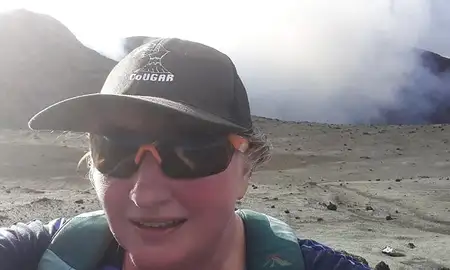
All volcanoes in Aotearoa New Zealand produce pyroclastic density currents, and they are responsible for NZs two deadliest volcanic disasters - the eruptions of Mount Tarawera in 1886 and Whakaari in 2019.
The article shows that pyroclastic density currents are considerably more destructive than previously thought. The research examines why are they so destructive and how we can learn to accurately predict the hazards of these currents.
The opacity and violence of natural flows prevents any direct probing inside pyroclastic currents. Instead, volcanologists apply theoretical hazard models to predict the intensity of hazards before a disaster strikes.
To test this approach, Massey researchers, with collaborators from the University of Edinburgh, University of California Santa Barbara, University of Oregon and the Earth Observatory of Singapore synthesised the natural conditions of pyroclastic currents using a unique large-scale eruption simulator.
The Massey researchers included PhD students Daniel Uhle and Lucas Corna, Postdoctoral Fellow Ermanno Brosch, and Professor Gert Lube.

Research Lead Professor Lube
Research Lead Professor Lube says they collected several tonnes of volcanic pumice and ash material from a volcano in New Zealand, filled it into a large hopper, heated it and dropped it onto a 35-metre long, instrumented runout section.
“We installed vertical profiles of dynamic pressure and temperature sensors along the flow path to directly measure the mechanical and thermal destructiveness inside the flows,” he explains.
The results showed the destructive power of the experimental pyroclastic currents exceeded that estimated through conventional hazard models by more than one order of magnitude. The researchers discovered that this hazard exacerbation occurs due to a resonance effect between the volcanic particles and gas inside pyroclastic currents. Unlike a homogeneous suspension of particles in a fluid, this resonance affect forces particles to concentrate at the peripheries of turbulent eddies to elevate damage-causing dynamic pressure inside flows.
“The significant deviation of the measured destructive power inside pyroclastic currents from that assumed in hazard models is alarming. It can mean the difference between life and death in different reaches of flow runout. A two-story, re-enforced brick building that may endure only minor damage to windows and doors, given conventional hazard prediction, would be entirely destroyed,” Professor Lube says.
The article was published in the journal Communications Earth & Environment. You can read the article here.
Related news
New funding awarded to pioneering research strengthening volcanic resilience
New funding from Toka Tū Ake Earthquake Commission (EQC) has been awarded to a first-of-its-kind research project on infrastructure resilience to volcanic activity, led by Associate Professor Carol Stewart.

Academic appointed Editor-in-Chief of the Journal of Applied Volcanology
Dr Emma Hudson-Doyle has been announced as the new Editor-in-Chief of the prestigious international Journal of Applied Volcanology.

Hunga Volcano eruption and its once-in-a-century atmospheric wave
Hunga Volcano in the Kingdom of Tonga began a new eruptive sequence on 19 December 2021, culminating in the climactic eruption on 15 January 2022.
